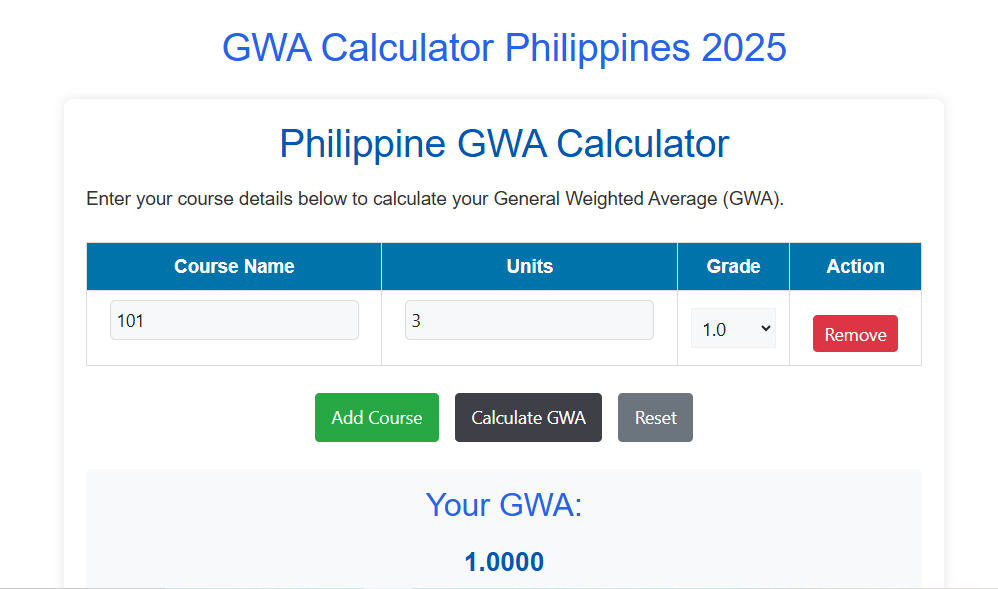
How to Easily Calculate Your Grades Online Without Complex Formulas
Let’s be real. Manually figuring out your grades isn’t exactly fun. Most students either get confused or just put it
Your CGPA =
The cumulative grade point average (CGPA) is a key indicator of a student’s academic success over a specific time period in the world of education. It gives a numerical depiction of a student’s accomplishments and provides information about their overall development and knowledge gain. This in-depth article tries to analyse the idea of CGPA by examining its elements, importance, calculating processes, and real-world instances.
An international standard metric used by educational institutions to assess a student’s academic performance is the cumulative grade point average, or CGPA. It is especially common in systems that use a credit-based curriculum, such as colleges, high schools, and universities.
Grades: Grades serve as a signal for how well a student performed in a particular subject. They frequently use a letter-based system, such as A, B, C, D, and F, where A stands for failure and F for great achievement.
Grade Points: A precise numerical value, known as a grade point, is assigned to each grade. These stats show how well the performance was done. As an illustration, an A might receive 4 points, a B might receive 3, and so on.
Holistic Assessment: By incorporating a student’s achievement across various topics, the CGPA offers a holistic assessment of their academic path. It provides a thorough understanding of both their advantages and disadvantages.
Comparison: The CGPA makes it simple to compare students and institutions. It functions as a standardised metric that helps hiring managers, admissions panels, and scholarship sponsors to objectively evaluate applicants.
Performance tracking: By keeping track of changes in CGPA over time, students can assess their development, pinpoint areas for development, and establish reasonable academic objectives.
Weighted Average approach: This approach entails multiplying each course’s grade points by the course’s assigned number of credits, adding these results, and then dividing by the overall number of credits. It can be stated mathematically as follows:
CGPA is equal to ((GP * CH)) / (CH).
Where GP stands for Grade Points, CH for Credit Hours, and for the aggregate of all courses.
Calculation on a semester basis: The CGPA is calculated on a semester basis in various educational institutions. The grade point average of all the courses taken during a semester is used to calculate the cumulative grade point average (CGPA).
Cumulative Approach: By averaging the semester-level CGPAs and giving each semester a different weight based on the amount of attempted credits, the total CGPA is determined.
Let’s take a look at a fictitious student named Alex who wants to earn a bachelor’s degree in computer science. The following classes make up Alex’s semester-long course schedule:
CourseNumber of Grade PointsHours of Credit
Semester CGPA is equal to (3 + 4 + 3 + 2) / (4 * 3 + 3 * 4 + 3.7 * 3 + 3.3 * 2), or 3.58.
Let’s say Alex has finished three semesters with 15, 16, and 14 credits each.
((Sem1 CGPA * 15) + (Sem2 CGPA * 16) + (Sem3 CGPA * 14)) / (15 + 16 + 14) equals the overall CGPA.
Overall CGPA = ((3.58 * 15) + (3.75 * 16) + (3.92 * 14)) / 45 3.75 based on the values.
Academic Opportunities: Scholarships, honours programs, and opportunities for additional study are all made possible by high GPAs. Additionally, it makes it more likely to get accepted into highly selective graduate programs.
Employment Prospects: A lot of employers use CGPA as a primary criterion for assessing applicants. Although not the only factor in determining employability, a high CGPA can help a candidate stand out in a crowded employment market.
Personal Development: Although crucial, CGPA shouldn’t be the only factor in determining a student’s path. It’s crucial to concentrate on all aspects of growth, such as extracurricular pursuits, internships, and skill improvement.
Subjectivity: Grading systems at various universities may differ, making direct comparison difficult.
Grade Inflation/Deflation: Grade inflation (inflated grades relative to performance) and grade deflation (lower grades for the same level of effort) are two outcomes of institutional strategies.
Individual Factors: Due to outside variables like health problems, difficult personal situations, or insufficient course options, a student’s CGPA may not always accurately reflect their full ability.
One crucial indicator for evaluating the success of students is the cumulative grade point average. The CGPA provides a thorough assessment of academic accomplishment because it takes into account grades, grade points, and credit hours. Beyond the academic sphere, its importance affects future prospects and offers a glimpse into a student’s journey. To succeed in the future, one must view CGPA as one component of a rich academic experience while also taking into account one’s own development, experiences, and skills.
When students need to apply for jobs, scholarships, or further education where percentage-based evaluation is required, it is usual practice in academic environments to convert the cumulative grade point average (CGPA) to a percentage. The percentage represents relative performance on a scale of 100 points, whereas the CGPA is a conventional way to measure academic performance. In order to explain the relevance of this conversion and provide a step-by-step tutorial for precise computation, this article digs into the process and examples of converting CGPA to %.
A cumulative grade point average (CGPA) is a weighted average of grade points gained in different courses that is frequently computed on a scale of 4.0 or 10.0, depending on the institution. It gives an extensive picture of a student’s academic progress over several semesters. While 100% is the maximum possible score under the percentage system, performance is assessed based on the total marks earned in a specific course.
Students who wish to apply for jobs, scholarships, or entrance to organisations that base admission decisions on percentages must convert their cumulative grade point average (CGPA) to percentage. Because it is straightforward and widely accepted, the % approach is preferred by many organisations and employers. An accurate conversion ensures that a student’s performance is fairly represented.
Methodology: The conversion method changes depending on the institution’s unique scale and whether grades are given on a scale of 4.0 or 10.0. The general equation to convert CGPA to % is as follows:
Percentage = (CGPA / Maximum CGPA) * 100
Identify the Grading Scale:
Determine whether the institution follows a 4.0 or 10.0 grading scale. This information is crucial for accurate conversion.
Obtain the Maximum CGPA:
Find out the highest possible CGPA achievable in the given system (4.0 or 10.0). This value is needed for the conversion formula.
Calculate the Percentage:
Apply the conversion formula to calculate the equivalent percentage. Multiply the obtained CGPA by 100 and divide by the maximum CGPA.
Let’s consider two scenarios: one with a 4.0 CGPA scale and the other with a 10.0 CGPA scale.
4.0 CGPA Scale
Suppose a student has a CGPA of 3.6 on a 4.0 scale.
Grading Scale: 4.0
CGPA: 3.6
Maximum CGPA in a 4.0 scale: 4.0
Using the conversion formula:
Percentage = (3.6 / 4.0) * 100 = 90.0%
So, a CGPA of 3.6 on a 4.0 scale corresponds to a percentage of 90.0%.
10.0 CGPA Scale
Consider a student with a CGPA of 8.2 on a 10.0 scale.
Grading Scale: 10.0
CGPA: 8.2
Maximum CGPA in a 10.0 scale: 10.0
Using the conversion formula:
Percentage = (8.2 / 10.0) * 100 = 82.0%
In this case, a CGPA of 8.2 on a 10.0 scale translates to a percentage of 82.0%.
In academic and professional life, the process of converting CGPA to percentage is crucial. It guarantees that a student’s achievement is fairly represented at institutions that demand a percentage-based grading. Accurate results depend on using the right conversion formula and understanding the grading system. Students can safely convert their CGPA to the equal percentage by using the techniques and examples in this article, making it easier for them to apply for jobs, scholarships, and graduate school.

Let’s be real. Manually figuring out your grades isn’t exactly fun. Most students either get confused or just put it

AI (Artificial Intelligence) has been integrated into the depths of many industries, and education is no exception. A survey conducted

Imagine you need to apply for a government service, pay a bill, or check your land records. Earlier, you might

Imagine if you could access all government services in Rajasthan with just one ID — no more juggling usernames and

A single scholarship can change your whole academic path, but you have to apply in the right way. With the

Why a Great Teacher CV Matters First Impressions Count Your CV is your first handshake with a potential employer—make it